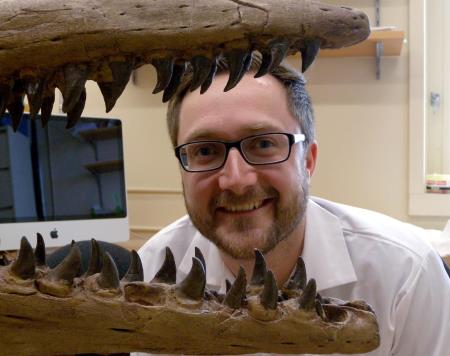
Dinosaurs don't go to the dentist, mostly because they're extinct. But did they develop gum disease or cavities? It could be possible says UAlberta paleontologist Aaron LeBlanc who specializes in studying the tooth development and dental tissues of these extraordinary creatures that once roamed freely.
Dinosaurs and dentistry have one thing in common - teeth. And their teeth are a lot more similar to human teeth than you may think.
Despite their massive size, and the inevitable fact that dinosaurs are extinct, dinosaur tooth formation and growth tie them in to modern dentistry quite nicely.
"The tissues that make up dinosaur teeth are the exact same as our teeth," says LeBlanc. "They have the same building blocks as human teeth. We say dinosaurs are primitive and extinct, but their teeth are built fundamentally the same as ours."
LeBlanc says his research has just begun to scratch the surface when it comes to studying dinosaur teeth. Traditionally, paleontologists have spent centuries studying fossils, but cutting open the teeth and examining the tissues is bit of a lost art.
Another similarity between human and dinosaur teeth is in how the teeth are anchored to the jaw bone says LeBlanc.
"Our teeth are suspended in the tooth socket with a ligament which allows for movement. This cushions the blows to the teeth as we chew on our food. Dinosaurs had a similar ligament like humans," says LeBlanc, adding the only other animals alive today that have this ligament are alligators and crocodiles. "This makes dinosaurs more relatable to alligators and crocodiles than any other
animal. Crocs and dinosaurs have clearly inherited this from a common ancestor millions and millions of years ago, we just don't know why."
LeBlanc says that this ligament is also the reason braces work in humans. So maybe braces would have worked on dinosaurs too.
"I'm still looking for cavities in dinosaurs," he jokes. "They have to be out there. I've also seen some weird sickly-looking samples of their teeth so gum disease and other disorders are quite possible."
The most interesting aspect of dinosaur teeth is the rate at which they would lose and grow new teeth.
"Dinosaurs didn't have just one set of adult teeth. In the fastest cases, every month or two their teeth would fall out and new ones would grow in," he says. "They were tooth factories and went through them like nobody's business."
LeBlanc's favourite dinosaur is the duckbill or hadrosaur dinosaur - a dinosaur that had more than 300 teeth jammed together in each side of the jaw to make one grinding surface.
"It's fascinating to see how dinosaurs adapted their teeth to deal with different diets. The enamel in dinosaurs changes depending on the diet. The duckbill's enamel is more durable, whereas the enamel on a Tyrannosaurus rex tooth is paper thin," he says, adding the enamel on the T.Rex is only one-fifth as thick as the enamel of human tooth.
By dissecting dinosaur teeth, LeBlanc says it's helped paleontologists identify when certain dental diseases showed up like ankyloses, where the teeth are fused to the jaw.
"The funny thing is we use the term dinosaur for something primitive, but dinosaurs were a specialized group of animals, and that's best reflected in their teeth," he says.